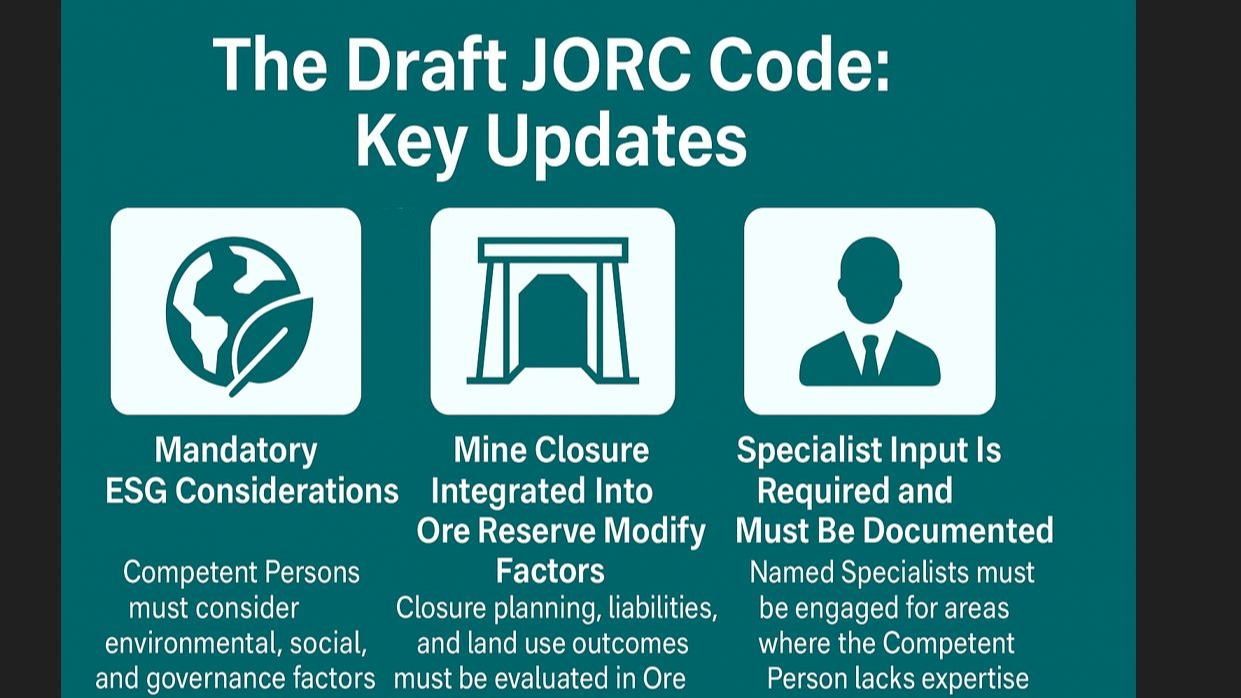The Joint Ore Reserves Committee (JORC) has released its draft 2024 Code for public consultation, setting the stage for a step-change in the way Australia’s mining and resources industry communicates project viability and value.
This isn’t just a technical update—it’s a fundamental realignment with the modern expectations of investors, regulators, financiers, and communities. The proposed changes embed Environmental, Social and Governance (ESG) considerations, mine closure planning, and the structured use of multidisciplinary specialists into the core of public reporting for Exploration Results, Mineral Resources, and Ore Reserves.
Gone are the days when modifying factors could be treated as a footnote. The draft JORC Code signals that a project’s success is not just defined by geology and economics, but also by its social licence, environmental footprint, regulatory credibility, and long-term legacy.
Key Updates in the Draft JORC Code (2024)
1. Mandatory ESG Considerations in Public Reporting
The most prominent update is the introduction of mandatory ESG evaluation in all stages of reporting. ESG is now positioned as a core modifying factor—placing the onus on Competent Persons (CPs) to either directly assess, or transparently acknowledge, the ESG risks and opportunities that influence project outcomes.
What this means in practice:
- Environmental: Assessment of biodiversity impacts, water security, tailings and waste management, land disturbance, climate-related risks (e.g. flooding or bushfire), greenhouse gas emissions, and rehabilitation obligations.
- Social: Consideration of local and Indigenous community expectations, cultural heritage protections, landholder access, workforce capacity, housing impacts, and the project’s social licence to operate.
- Governance: Transparency regarding permitting pathways, compliance status, regulatory uncertainty, land tenure, and alignment with company governance structures and ESG performance frameworks.
Importantly, the Code does not expect every CP to be an ESG expert—but it does expect CPs to understand when ESG risks are material, and to engage recognised Specialists to fill those knowledge gaps. These ESG aspects will need to be explicitly described, not just assumed.
2. Mine Closure Is a Core Part of Reserve Evaluation
Another pivotal change is the formal integration of mine closure planning and liabilities into the Reserve estimation process. The Code makes clear that closure is not a distant event—it is a present-day risk that must be modelled and costed.
Competent Persons will now need to:
- Demonstrate that closure costs (progressive and final) have been quantified and factored into financial modelling
- Identify whether closure plans are approved, under development, or contested
- Account for the feasibility of relinquishment and any long-term monitoring obligations
- Assess how post-mining land uses align with community and regulatory expectations
- Consider whether residual risk could materially alter project viability, either technically or reputationally
Closure planning is no longer optional. It must now be aligned with life-of-mine scheduling, project valuation, and the narrative presented to markets.
3. Specialist Input is Mandatory, Not Just Preferred
The draft Code introduces an explicit requirement: if the Competent Person lacks competence in an area material to the project’s outcome, a named and qualified Specialist must be engaged, and their input clearly documented in the Public Report.
This includes (but is not limited to):
- ESG
- Tailings and water management
- Geotechnical risk
- Heritage and community engagement
- Closure planning
- Hydrogeology or groundwater modelling
This promotes transparency, prevents unqualified commentary, and ensures that assumptions are properly interrogated. The use of Specialists must be scoped, sourced, and declared—in other words, integrated into the reporting framework, not appended as an afterthought.
IEMA’s Role: Helping You Adapt and Thrive
At IEMA, we see this new Code as a welcome evolution, but not one that needs to be over complicated or adding multiple layers to the process. We’ve long believed that credible projects require more than strong geology—they demand strong governance, sound closure planning, and a clear understanding of community and environmental risk.
With decades of experience across exploration, operations, approvals, closure, and post-mining land use, our team offers more than technical input—we offer strategic perspective built on real-world project delivery.
We don’t just advise. We have walked in your shoes.
How We Help Clients Navigate the Draft JORC Code
- Integrated Risk Assessment We use structured frameworks to assess ESG, regulatory, and reputational risks early—helping you identify what matters most to Reserve classification, and ensuring modifying factors are fully substantiated.
- Closure Planning & Liability Management Our experts deliver costed closure plans, final landform concepts, progressive rehab strategies, and relinquishment pathways. We support mining clients in transforming closure from a compliance cost into a strategic advantage.
- Specialist Input & Validation From biodiversity and hydrogeology to tailings risk and heritage, we provide recognised Specialists who work closely with our team to support your Competent Persons. This collaborative model ensures your public reports are defensible and JORC-compliant—technically, socially, and environmentally.
- Strategic Reporting & Communications We help clients align internal studies, stakeholder strategies, and JORC reporting obligations into a single, cohesive narrative—reducing risk and improving investor confidence.
- Training, Mentoring & Peer Review Need to uplift capability within your team? We provide internal mentoring, technical peer review, and CP support to help organisations adapt to the Code’s expectations and embed them in business-as-usual.
Whilst the Code is in Draft with the public submissions being considered by the JORC committee, there is a real opportunity to get on the front foot and start to have conversations around what this means for your projects. Don’t wait till it drops and get in front of the curve on this issue.
